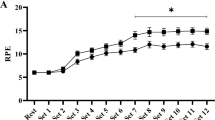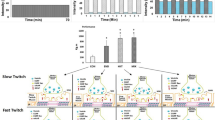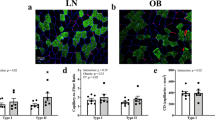Abstract
Muscle contraction stimulates a transient change of myogenic factors, partly related to the mode of contractions. Here, we assessed the response of IGF-1Ea, IGF-1Eb, IGF-1Ec, PGC1α-1, PGC1α-4, and myostatin to the eccentric Vs. the concentric contraction in human skeletal muscle. Ten healthy males were performed an acute eccentric and concentric exercise bout (n = 5 per group). For each contraction type, participants performed 12 sets of 10 repetitions knee extension by the dominant leg. Baseline and post-exercise muscle biopsy were taken 4 weeks before and immediately after experimental sessions from Vastus Lateralis muscle. Genes expression was measured by real-time PCR technique. There was a significant increase in PGC1α-1, PGC1α-4, IGF-1Ea and, IGF-1Eb mRNA after concentric contraction (p ≤ 0.05), while the PGC1α-4 and IGF-1Ec significantly increased after eccentric contraction (p ≤ 0.05). It is intriguing to highlight that; no significant differences between groups were evident for changes in any variables following exercise bouts (p ≥ 0.05). Our results found that concentric and eccentric contractions presented different responses in PGC1α-1, IGF-1Ea, IGF-1Eb, and IGF-1Ec mRNA. However, a similar significant increase in mRNA content was observed in PGC1α-4. Further, no apparent differences could be found between the response of genes to eccentric and concentric contraction.


Similar content being viewed by others
Abbreviations
- CON:
-
Concentric
- ECC:
-
Eccentric
- GAPDH:
-
Glyceraldehyde 3-phosphate dehydrogenase
- HIIT:
-
High-intensity interval training
- IGF-1:
-
Insulin-like growth factor-1
- MGF:
-
Mechano growth factor
- mRNA:
-
Messenger ribonucleic acid
- MVIA:
-
Maximal voluntary isometric actions
- PGC-1 alpha:
-
Peroxisome proliferator-activated receptor gamma coactivator 1-alpha
- RE:
-
Resistance exercise
- RT-PCR:
-
Real-time polymerase chain reaction
References
Schnyder S, Handschin C (2015) Skeletal muscle as an endocrine organ: PGC-1α, myokines and exercise. Bone 80:115–125
Hickson RC, Hidaka K, Foster C (1994) Skeletal muscle fiber type, resistance training, and strength-related performance. Med Sci Sports Exerc 26(5):593–598
Carter HN, Pauly M, Tryon LD, Hood DA (2018) Effect of contractile activity on PGC-1α transcription in young and aged skeletal muscle. J Appl Physiol 124(6):1605–1615
Kang C, Ji LL (2012) Role of PGC-1α signaling in skeletal muscle health and disease. Ann N Y Acad Sci 1271(1):110
Puigserver P, Spiegelman BM (2003) Peroxisome proliferator-activated receptor-gamma coactivator 1 alpha (PGC-1 alpha): transcriptional coactivator and metabolic regulator. Endocr Rev 24(1):78–90
Ruas JL, White JP, Rao RR, Kleiner S, Brannan KT, Harrison BC et al (2012) A PGC-1alpha isoform induced by resistance training regulates skeletal muscle hypertrophy. Cell. 151(6):1319–1331
Olesen J, Kiilerich K, Pilegaard H (2010) PGC-1α-mediated adaptations in skeletal muscle. Pflügers Arch Eur J Physiol 460(1):153–162
Lundberg TR, Fernandez-Gonzalo R, Norrbom J, Fischer H, Tesch PA, Gustafsson T (2014) Truncated splice variant PGC-1α4 is not associated with exercise-induced human muscle hypertrophy. Acta Physiol 212(2):142–151
Dieli-Conwright CM, Kiwata JL, Tuzon CT, Spektor TM, Sattler FR, Rice JC et al (2016) Acute response of PGC-1alpha and IGF-1 isoforms to maximal eccentric exercise in skeletal muscle of postmenopausal women. J Strength Cond Res 30(4):1161–1170
Sandri M, Lin J, Handschin C, Yang W, Arany ZP, Lecker SH et al (2006) PGC-1α protects skeletal muscle from atrophy by suppressing FoxO3 action and atrophy-specific gene transcription. Proc Natl Acad Sci 103(44):16260–16265
Wang L, Mascher H, Psilander N, Blomstrand E, Sahlin K (2011) Resistance exercise enhances the molecular signaling of mitochondrial biogenesis induced by endurance exercise in human skeletal muscle. J Appl Physiol 111(5):1335–1344
Schwarz NA, McKinley-Barnard SK, Spillane MB, Andre TL, Gann JJ, Willoughby DS (2016) Effect of resistance exercise intensity on the expression of PGC-1α isoforms and the anabolic and catabolic signaling mediators, IGF-1 and myostatin, in human skeletal muscle. Appl Physiol Nutr Metab 41(8):856–863
Musaro A, McCullagh K, Paul A, Houghton L, Dobrowolny G, Molinaro M et al (2001) Localized Igf-1 transgene expression sustains hypertrophy and regeneration in senescent skeletal muscle. Nat Genet 27(2):195–200
Dobrowolny G, Giacinti C, Pelosi L, Nicoletti C, Winn N, Barberi L et al (2005) Muscle expression of a local Igf-1 isoform protects motor neurons in an ALS mouse model. J Cell Biol 168(2):193–199
Timmer LT, Hoogaars WM, Jaspers RT (2018) The role of IGF-1 signaling in skeletal muscle atrophy. Springer, New York, pp 109–137
Adams GR, Haddad F, Bodell PW, Tran PD, Baldwin KM (2007) Combined isometric, concentric, and eccentric resistance exercise prevents unloading-induced muscle atrophy in rats. J Appl Physiol 103(5):1644–1654
Xiao W, Chen P, Wang R, Dong J (2013) Overload training inhibits phagocytosis and ROS generation of peritoneal macrophages: role of IGF-1 and MGF. Eur J Appl Physiol 113(1):117–125
Hameed M, Lange KH, Andersen JL, Schjerling P, Kjaer M, Harridge SD et al (2004) The effect of recombinant human growth hormone and resistance training on IGF-I mRNA expression in the muscles of elderly men. J Physiol 555(Pt 1):231–240
McKay BR, O’Reilly CE, Phillips SM, Tarnopolsky MA, Parise G (2008) Co-expression of IGF-1 family members with myogenic regulatory factors following acute damaging muscle-lengthening contractions in humans. J Physiol 586(22):5549–5560
Lee SJ (2007) Quadrupling muscle mass in mice by targeting TGF-beta signaling pathways. PLoS One 2(8):e789
Matsakas A, Bozzo C, Cacciani N, Caliaro F, Reggiani C, Mascarello F et al (2006) Effect of swimming on myostatin expression in white and red gastrocnemius muscle and in cardiac muscle of rats. Exp Physiol 91(6):983–994
Wehling M, Cai B, Tidball JG (2000) Modulation of myostatin expression during modified muscle use. FASEB J 14(1):103–110
Haddad F, Adams GR, Bodell PW, Baldwin KM (2006) Isometric resistance exercise fails to counteract skeletal muscle atrophy processes during the initial stages of unloading. J Appl Physiol 100(2):433–441
Jensky NE, Sims JK, Dieli-Conwright CM, Sattler FR, Rice JC, Schroeder ET (2010) Exercise does not influence myostatin and follistatin mRNA expression in young women. J Strength Cond Res 24(2):522
Heinemeier KM, Olesen JL, Schjerling P, Haddad F, Langberg H, Baldwin KM et al (2007) Short-term strength training and the expression of myostatin and IGF-I isoforms in rat muscle and tendon: differential effects of specific contraction types. J Appl Physiol 102(2):573–581
Roschel H, Ugrinowistch C, Santos AR, Barbosa WP, Miyabara EH, Tricoli V et al (2018) Effect of eccentric action velocity on expression of genes related to myostatin signaling pathway in human skeletal muscle. Biol Sport 35(2):111
Isner-Horobeti ME, Rasseneur L, Lonsdorfer-Wolf E, Dufour SP, Doutreleau S, Bouitbir J et al (2014) Effect of eccentric versus concentric exercise training on mitochondrial function. Muscle Nerve 50(5):803–811
Franchi MV, Reeves ND, Narici MV (2017) Skeletal muscle remodeling in response to eccentric vs. concentric loading: morphological, molecular, and metabolic adaptations. Front Physiol 8:447
Hody S, Croisier JL, Bury T, Rogister B, Leprince P (2019) Eccentric muscle contractions: risks and benefits. Front Physiol 10:536
Fernandez-Gonzalo R, Lundberg TR, Alvarez-Alvarez L, de Paz JA (2014) Muscle damage responses and adaptations to eccentric-overload resistance exercise in men and women. Eur J Appl Physiol 114(5):1075–1084
Pugh JK, Faulkner SH, Jackson AP, King JA, Nimmo MA (2015) Acute molecular responses to concurrent resistance and high-intensity interval exercise in untrained skeletal muscle. Physiol Rep 3(4)
Silveira LR, Pilegaard H, Kusuhara K, Curi R, Hellsten Y (2006) The contraction induced increase in gene expression of peroxisome proliferator-activated receptor (PPAR)-γ coactivator 1α (PGC-1α), mitochondrial uncoupling protein 3 (UCP3) and hexokinase II (HKII) in primary rat skeletal muscle cells is dependent on reactive oxygen species. Biochimica et Biophysica Acta (BBA) Mol Cell Res 1763(9):969–976
Pilegaard H, Saltin B, Neufer PD (2003) Exercise induces transient transcriptional activation of the PGC-1alpha gene in human skeletal muscle. J Physiol 546(Pt 3):851–858
Kang C, Chung E, Diffee G, Ji LL (2013) Exercise training attenuates aging-associated mitochondrial dysfunction in rat skeletal muscle: role of PGC-1α. Exp Gerontol 48(11):1343–1350
Allan R, Sharples AP, Cocks M, Drust B, Dutton J, Dugdale HF et al (2019) Low pre-exercise muscle glycogen availability offsets the effect of post-exercise cold water immersion in augmenting PGC-1α gene expression. Physiol Rep 7(11):e14082
Psilander N, Damsgaard R, Pilegaard H (2003) Resistance exercise alters MRF and IGF-I mRNA content in human skeletal muscle. J Appl Physiol 95(3):1038–1044
Roberts MD, Dalbo VJ, Sunderland KL, Poole CN, Hassell SE, Bemben D et al (2010) IGF-1 splice variant and IGF-1 peptide expression patterns in young and old human skeletal muscle prior to and following sequential exercise bouts. Eur J Appl Physiol 110(5):961–969
Bamman MM, Petrella JK, Kim JS, Mayhew DL, Cross JM (2007) Cluster analysis tests the importance of myogenic gene expression during myofiber hypertrophy in humans. J Appl Physiol 102(6):2232–2239
Ahtiainen JP, Lehti M, Hulmi JJ, Kraemer WJ, Alen M, Nyman K et al (2011) Recovery after heavy resistance exercise and skeletal muscle androgen receptor and insulin-like growth factor-I isoform expression in strength trained men. J Strength Cond Res 25(3):767–777
Wilborn CD, Taylor LW, Greenwood M, Kreider RB, Willoughby DS (2009) Effects of different intensities of resistance exercise on regulators of myogenesis. J Strength Cond Res 23(8):2179–2187
Ascenzi F, Barberi L, Dobrowolny G, Villa Nova Bacurau A, Nicoletti C, Rizzuto E et al (2019) Effects of IGF-1 isoforms on muscle growth and sarcopenia. Aging Cell 18(3):e12954
Fornaro M, Hinken AC, Needle S, Hu E, Trendelenburg A-U, Mayer A et al (2014) Mechano-growth factor peptide, the COOH terminus of unprocessed insulin-like growth factor 1, has no apparent effect on myoblasts or primary muscle stem cells. Am J Physiol Endocrinol Metab 306(2):E150–E1E6
Hameed M, Toft AD, Pedersen BK, Harridge SD, Goldspink G (2008) Effects of eccentric cycling exercise on IGF-I splice variant expression in the muscles of young and elderly people. Scand J Med Sci Sports 18(4):447–452
Kim J-S, Cross JM, Bamman MM (2005) Impact of resistance loading on myostatin expression and cell cycle regulation in young and older men and women. Am J Physiol Endocrinol Metab 288(6):E1110–E11E9
Hill M, Wernig A, Goldspink G (2003) Muscle satellite (stem) cell activation during local tissue injury and repair. J Anat 203(1):89–99
Kambadur R, Sharma M, Smith TP, Bass JJ (1997) Mutations in myostatin (GDF8) in double-muscled Belgian blue and Piedmontese cattle. Genome Res 7(9):910–915
Raue U, Slivka D, Jemiolo B, Hollon C, Trappe S (2006) Myogenic gene expression at rest and after a bout of resistance exercise in young (18–30 yr) and old (80–89 yr) women. J Appl Physiol 101(1):53–59
Mathers JL, Farnfield MM, Garnham AP, Caldow MK, Cameron-Smith D, Peake JM (2012) Early inflammatory and myogenic responses to resistance exercise in the elderly. Muscle Nerve 46(3):407–412
Dalbo VJ, Roberts MD, Sunderland KL, Poole CN, Stout JR, Beck TW et al (2011) Acute loading and aging effects on myostatin pathway biomarkers in human skeletal muscle after three sequential bouts of resistance exercise. J Gerontol A Biol Sci Med Sci 66(8):855–865
Farthing JP, Chilibeck PD (2003) The effects of eccentric and concentric training at different velocities on muscle hypertrophy. Eur J Appl Physiol 89(6):578–586
Acknowledegments
We would like to thank the subjects and personnel of the University of Tehran and the Faculty of Medical Sciences for their assistance with the clinical portion of this study.
Funding
Any institutes did not fund this study.
Author information
Authors and Affiliations
Corresponding author
Ethics declarations
Conflict of interest
The authors declare no conflict of interest.
Ethical approval
All procedures performed in studies involving human participants were by the ethical standards of the ethical committee of Tehran University (Ethic No: IR.UT.SPORT.REC.1397.029) and with the 1964 Helsinki declaration and its later amendments or comparable ethical standards.
Informed consent
Informed consent was obtained from all individual participants included in the study.
Additional information
Publisher’s note
Springer Nature remains neutral with regard to jurisdictional claims in published maps and institutional affiliations.
Rights and permissions
About this article
Cite this article
Taghibeikzadehbadr, P., Shirian, S. & Sabouri, M. Effect of different muscle contraction mode on the expression of Myostatin, IGF-1, and PGC-1 alpha family members in human Vastus Lateralis muscle. Mol Biol Rep 47, 9251–9258 (2020). https://doi.org/10.1007/s11033-020-06017-x
Received:
Accepted:
Published:
Issue Date:
DOI: https://doi.org/10.1007/s11033-020-06017-x




